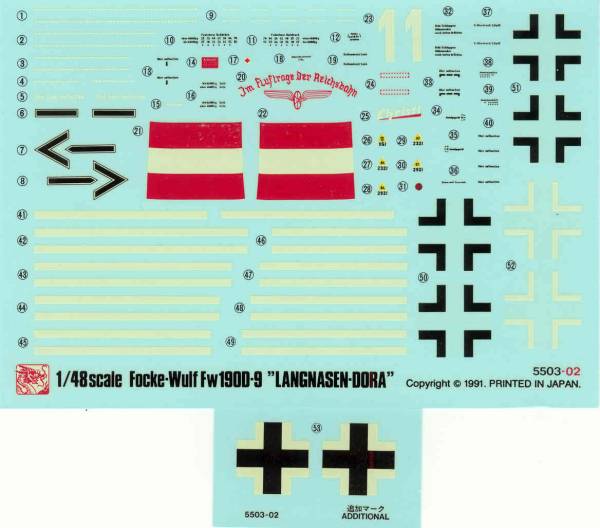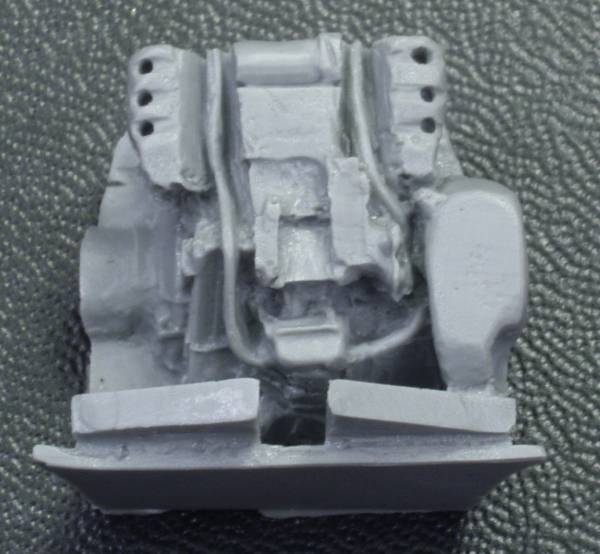

Fw 190D-9

The Fw 190D-9 was developed from the Fw 190V17 and V19 prototypes. Small batches of the 190D-0 and D-1 fighters for service evaluation were delivered and tested during the spring and summer of 1943. These were powered by Junkers Jumo 213A-1 twelve-cylinder inverted -Vee liquid-cooled engines rated at 1,776 h.p. for takeoff. This could be boosted to 2,240 h.p. by water / methanol injection. The engine improved the fighter's performance with the maximum speed being 432 m.p.h. for the D-1 version. To compensate for the lengthened nose, the rear fuselage was also lengthened, the overall length becoming 33 feet 11 inches. The vertical fin was increased in width. The standard Fw 190 wings and tailplane were retained. Armament consisted of two 13-mm. and two 20-mm. guns.
The first service version of the D series, the 190D-9, became operational with Jagdgeschwader Udet stationed at Detmold in the winter of 1943-44. The D-9's were even faster that the D-0 and D-1 series attaining 440 m.p.h. at 37,000 feet.
The Kit The Dragon Fw 190D-9 is
another kit that Dragon obtained when Trimaster went out of business.
It comes in a fairly good sized box considering the size of the kit and
it's a two part top opening box with nice artwork on the box top.
Inside the box are six small sprues. Three in one bag and one each in
three others. The clear parts were in a bag by themselves. The parts
are molded in a light gray plastic and feature recessed panel lines and
fasteners. The panel lines are fine and consistent and the surface is
smooth and glossy. Looking over the major airframe pieces I found no
significant surface blemishes. The control surfaces are all fixed and
the fabric areas were discretely rendered. Flash was minimal to non
existent on the major parts there was some light flash on the smaller
parts plus the usual parting lines. There are two separate cowl flap
pieces, one for open and one for closed flaps. There are a plethora of
unopened holes on the inside both the top and bottom wing halves for
various versions and weapons. The wheels wells are boxed in with a
separate part which has nice internal detail. There are few ejector pin
marks to be found, none on the inside of the gear doors but there is
one in the cockpit area. The kit has a fairly well appointed cockpit and
includes some photoetch to dress things up a bit. The kit also comes
with a bomb or drop tank that can be fitted. Altogether there are 76
parts in gray. See photos below. The clear parts are a little on
the thick side but reasonable clear and have well marked frame lines.
The canopy is in two parts so it can be posed open. All together there
are 5 clear parts for a kit total of 81 parts. See photo below. The kit supplied PE parts
include an instrument panel and other cockpit related goodies as well
as a couple exterior parts as well. See photo below. The decals are reasonably thin
and mostly in register. A couple are a bit off though. A small
secondary sheet was supplied apparently as an after thought. Markings
are suppled for two aircraft. A reasonable amount of stencils are
supplied. See photo below. The instructions are printed on
a long sheet folded to an A4 page size that creates eight panels. The
first has history and specifications in six languages. The second panel
has the usual safety warnings, icon chart, paint chart and the first
assembly instruction. The next three panels are assembly instructions.
The next two are painting and marking instructions and the last page
has a parts map and instructions for applying decals. After Market Goodies Not
much needed for this kit but I didn't like the instrument panels and
Eduard had some nice color ones in their color zoom set [FE49210] so I
went for it as I'm pathetic at painting up these German panels ! See
photo below.
I
also opted for a set of Quick Boost [48027] replacement exhaust stacks.
These are nicely cast in light gray resin and feature hollowed out ends. See
below.









Next up is an engine plug from Parts-R-Parts [PRP-003] this is a detail omitted from most of the 1/48 scale models of the D9 and represents the back end of the engine on the D9 which can be seen in the wheel wells. This was done to improve cooling while on the ground. The part is molded from a gray resin and has moderately sharp detail of the rear of the Jumo engine and some of the other associated parts such as the tank for the coolant. To make it look better it still needs a couple of pipes added. The holes on the part shown in the photo below need to be filled and they are on the engine rocker covers. Once painted up and the additional pipes installed it should improve the looks of the this portion of the model.

And finally a replacement cowling from Eagle parts. The kit part is mostly flat in side profile whereas the prototype was more aerodynamic in shape and this part corrects that and provides a set of cowl flaps in the fully closed position. See photo below.

I also opted for aftermarket decals as well, this is EagleCals EC48-61.

Conclusions
This kit at
one time was the most accurate D-9 kit available and it is still a
nicely done kit. It has been released by a number of other
manufacturers over the years. While Trimaster based kits always seem to
have at least one or two gotchas it still should build into a nice
model of one of my all time favorite fighter aircraft.
Links to kit build or reviews
A build can be found here and here.
References
"Warplanes of the Third Reich" by William Green
Updated 10/10/08